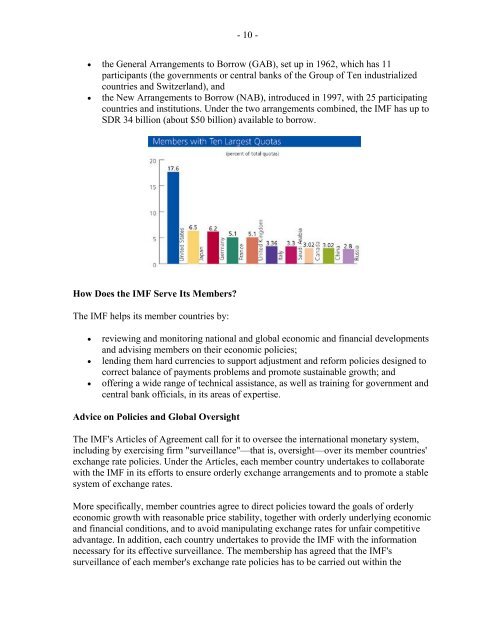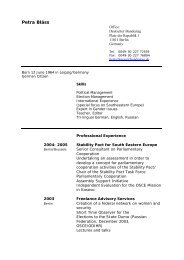What Is the International Monetary Fund? - the JVI eCampus!
What Is the International Monetary Fund? - the JVI eCampus!
What Is the International Monetary Fund? - the JVI eCampus!
You also want an ePaper? Increase the reach of your titles
YUMPU automatically turns print PDFs into web optimized ePapers that Google loves.
- 10 -<br />
• <strong>the</strong> General Arrangements to Borrow (GAB), set up in 1962, which has 11<br />
participants (<strong>the</strong> governments or central banks of <strong>the</strong> Group of Ten industrialized<br />
countries and Switzerland), and<br />
• <strong>the</strong> New Arrangements to Borrow (NAB), introduced in 1997, with 25 participating<br />
countries and institutions. Under <strong>the</strong> two arrangements combined, <strong>the</strong> IMF has up to<br />
SDR 34 billion (about $50 billion) available to borrow.<br />
How Does <strong>the</strong> IMF Serve Its Members?<br />
The IMF helps its member countries by:<br />
• reviewing and monitoring national and global economic and financial developments<br />
and advising members on <strong>the</strong>ir economic policies;<br />
• lending <strong>the</strong>m hard currencies to support adjustment and reform policies designed to<br />
correct balance of payments problems and promote sustainable growth; and<br />
• offering a wide range of technical assistance, as well as training for government and<br />
central bank officials, in its areas of expertise.<br />
Advice on Policies and Global Oversight<br />
The IMF's Articles of Agreement call for it to oversee <strong>the</strong> international monetary system,<br />
including by exercising firm "surveillance"—that is, oversight—over its member countries'<br />
exchange rate policies. Under <strong>the</strong> Articles, each member country undertakes to collaborate<br />
with <strong>the</strong> IMF in its efforts to ensure orderly exchange arrangements and to promote a stable<br />
system of exchange rates.<br />
More specifically, member countries agree to direct policies toward <strong>the</strong> goals of orderly<br />
economic growth with reasonable price stability, toge<strong>the</strong>r with orderly underlying economic<br />
and financial conditions, and to avoid manipulating exchange rates for unfair competitive<br />
advantage. In addition, each country undertakes to provide <strong>the</strong> IMF with <strong>the</strong> information<br />
necessary for its effective surveillance. The membership has agreed that <strong>the</strong> IMF's<br />
surveillance of each member's exchange rate policies has to be carried out within <strong>the</strong>



